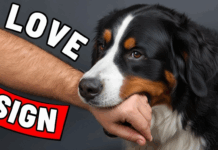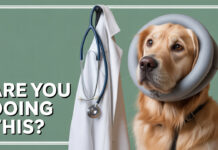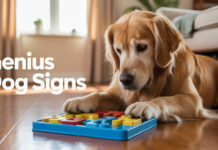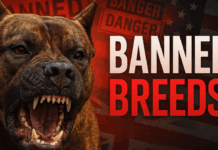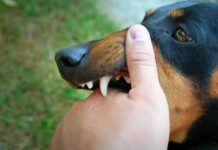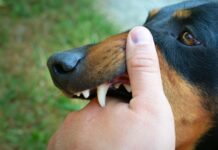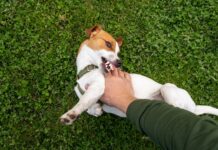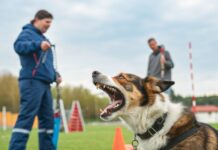Last Updated on December 8, 2021 by Dogs Vets
10 Proven Tips to Dog Proof Your Garden
If you have both an adorable dog and some flowers and plants in your garden or at home, you probably know that your dog may damage the flowers and plants, and some ornamental flowers and plants may also damage the health of your dog.
Perhaps you would like to know if there’s a way you can protect them both?
The answer is yes, you have several ways you can not only protect but also keep your valuable plants and cute pets happy and healthy.
Interested? Let’s explore!
10 Helpful Tips to Dog Proof Your Garden
The below-given tips can help you to create a dog-proof garden where your plants will grow and the dog will be safe and healthy.
1. Avoid Growing Plants That Are Poisonous to Your Doggy
You should always be aware of the poisonous plants that can harm your sweet dogs so badly and oblige yourself not to grow them in your garden as long as you have a dog at home.
This paragraph includes 10 of the most common plants and flowers that can be toxic to your dog, they are Lily of the valley, Philodendron, Dieffenbachia, Cyclamen, Southern Yew, Rhododendron/Azaleas, Oleander, Tulips, Sago Palm, and Autumn Crocus.
2. Install Fences Around the Garden
One of the most important steps you can take towards the safety of your dog and the garden is to install a strong six feet fence for a jumper doggy and a three and a half feet for a small one having no such holes through which the dog can escape.
This way you cannot only ensure that the dog doesn’t ruin its health but also not cross its area and jump to the place where it shouldn’t be, such as outside the yard.
3. Plant Beds and Build Borders
It is an essential point for a garden to have planted some beds, but to keep them secure, you can create some borders instead of the fence to prevent your dog from walking, eating, or peeing in those areas.
You can also purchase a piggy snout from Mirapets to prevent your dog from chewing on beautiful or poisonous plants.
The barriers must not be as high as the fences but just to leave a sign to your dog that it doesn’t get in there and ruin the plants or its health.
4. Avoid Planting Thorny Plants
Thorny plants are harmful to your beloved dog because thorns can lead your lovely dog to injury in its paws or other parts of the body, so one of the nicest tips is to keep your garden free from such plants, additionally, you can plant some other charming and non-toxic plants or flowers instead of them to make your garden look good.
5. Never Leave the Garden Entrance Opened
Leaving the garden gate open may or may not seem an important point to you because you usually keep it closed, but it’s a crucial point for the sake of a reminder that you should never leave it open for your valuable dog can mistakenly go out, and god forbid, you may lose it, or to prevent the entry of other dogs, and ruin the beauty of your garden.
6. Keep the Ponds and Pools Covered
As a dog owner, though you already know that playing in the water is entertainment for many of the adventurous and playful dogs and a way for them to make a connection with their favorite people, water can also be dangerous for your dog because the dog may get dirty, then get into the house and mess everything, consequently, it’s better to keep the pools and ponds covered unless they are in use.
7. Avoid Leaving Useless Soil
Generally speaking, digging is entertainment for dogs and a good way for them to reduce their stress and feel comfortable if they are bored, but keep in mind that digging can ruin a part of your garden that looks bad, make them dirty, and so, can make a mess inside the rooms when they enter.
To prevent this from happening, you have to take the useless soil away as you see it in your garden.
8. Provide Your Dog with a Safe Play Area
Provide your family-friendly dog with a specific place where it can play and spend most of its time without affecting the flowers and plants, plus keep it away from them in case any of them is toxic for the dogs.
You can make your dog’s life more enjoyable by providing it with some of its favorite toys that you can easily obtain from our recommended brand Mirapets.
9. Plant Densely and Wisely
If you have a precious dog at home, you must keep in mind while planting or seeding to do them quite densely and carefully.
You have to know which plants can be dangerous for your dog as mentioned above, and you should plant them pretty densely so that it becomes impossible for the dog to walk in and so it doesn’t try to get in and prevent itself and the plants from harm.
10. Reduce Hazards
Minimize keeping the tools or unnecessary objects in the garden that can be harmful to your dog, plus try to be a little cautious while walking in the garden and look for the harmful objects to remove, such as fragments or nails to make sure your dog remains safe.
You can also use an adjustable harness & leash to control your pet when you are with it and minimize accidents.

Conclusion
Even though having an ideal garden and keeping a dog may seem challenging, it becomes more interesting if you know about how to keep them both safe, and you have already learned those tips right above in this article. Furthermore, you can help your pet groom by using some of the items available with Mirapet.
Fact Check
We hope you enjoyed this article… What are your thoughts on 10 Proven Tips to Dog Proof Your Garden?
Рleаse let us knоw yоur thоughts in the соmments seсtiоn. Feel free to share with us in the comments section below.

